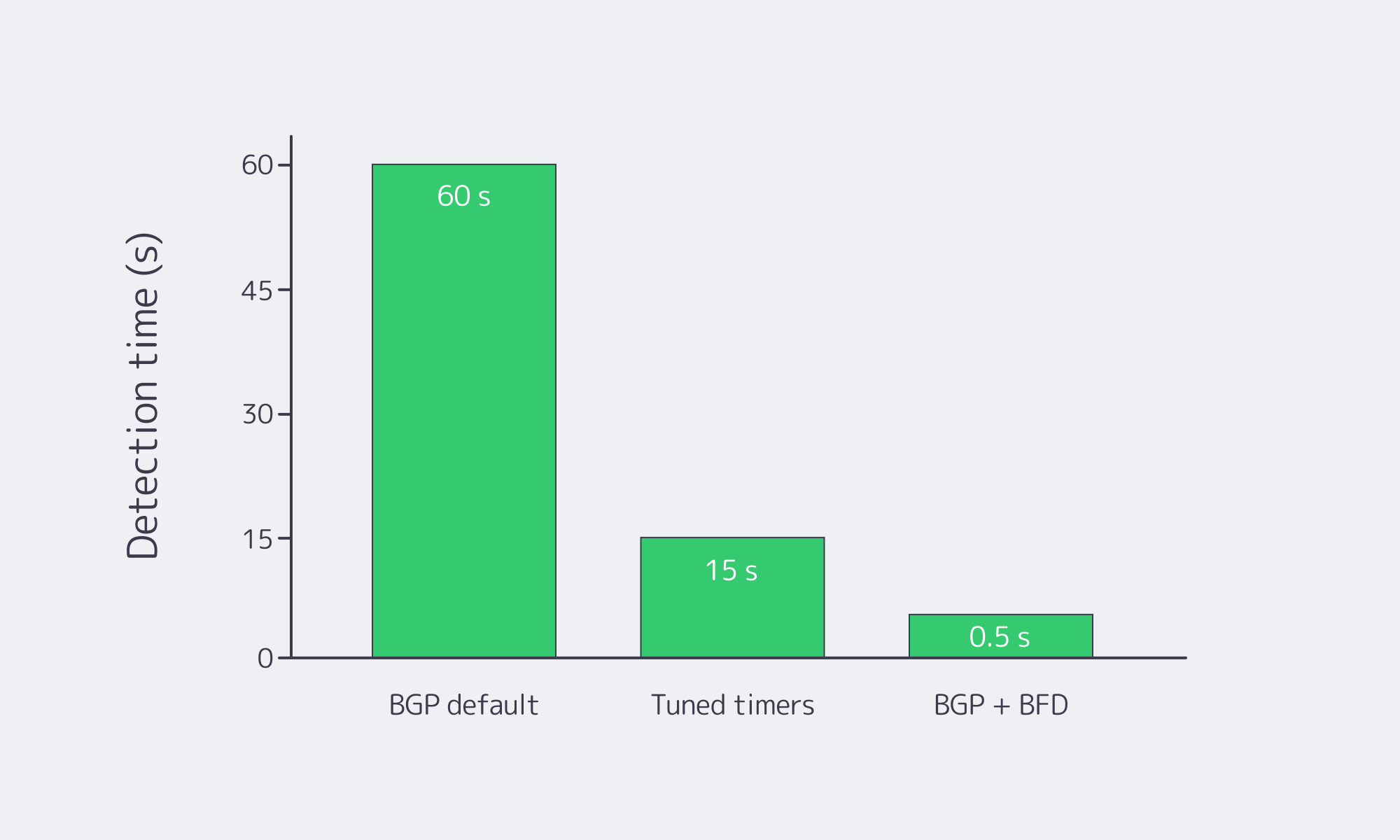Blog

BGP Multi-Homing: Reliability, Control, and Speed
Industry benchmarks still cite average losses near $5,600 per minute—a 2014 Gartner figure that remains a touchstone for risk planning. A single ISP outage can take entire application stacks dark, as seen during the August 30, 2020 CenturyLink/Level(3) incident that knocked out ~3.5% of global Internet traffic for several hours. Multi‑homing with BGP is the antidote: connect to multiple ISPs, let the border gateway protocol decide the best path, and fail over automatically when a path breaks.
Choose Melbicom— 1,000+ ready-to-go servers — 20 global Tier IV & III data centers — BGP sessions with BYOIP |
 |
What is BGP Multi‑Homing and Why Does It Matter for Reliability?
BGP multi‑homing means advertising your IP space to two or more upstream ISPs and receiving routes from each. When a provider fails, BGP withdraws the bad path and traffic shifts to the surviving ISP—no manual changes, no DNS TTLs to wait out. In steady state, you can use both links actively for load sharing, favor destinations by cost or latency, and shape inbound paths with policy (local‑pref, MED, AS‑path prepends, and communities). The result is resilience + control that single‑homed links simply don’t provide.
A core advantage over “backup‑only” designs: multi‑homed BGP isn’t idle capacity. With the border gateway routing protocol, you can keep links hot—for example, prefer ISP‑A to western Europe while favoring ISP‑B to East Asia, or send bulk backups over the cheaper link while keeping real‑time flows on the lower‑jitter path. Policy lives on the router, not in ticket queues.
How Does Border Gateway Protocol Routing Make Multi‑Homing Work in Practice?
At the edge, you run eBGP to each provider, announce your public prefixes, and ingest either full tables or defaults (depending on router scale). For outbound control, you set local preference to favor one ISP or split by destination. For inbound control, you influence the outside world’s choice of path using AS‑path prepending, selective advertisement of more‑specifics (where registries and filters allow), and BGP communities that request provider‑side action (e.g., de‑prefer with certain carriers). This is why multi‑homing with the BGP is as much policy engineering as plumbing.
Can BFD make failover essentially instant?
By default, BGP prioritizes stability, so neighbor‑down detection can be slow with conservative timers. Pairing BGP with Bidirectional Forwarding Detection (BFD) changes that. BFD runs millisecond‑level heartbeats at the forwarding plane and signals BGP to tear down sessions immediately upon failure, yielding sub‑second reconvergence in well‑tuned networks—documented directly in border gateway protocol Cisco references (“the main benefit of implementing BFD for BGP is a significantly faster reconvergence time”).
In practice, most teams combine modestly aggressive BGP hold timers with BFD for the truly fast link‑or‑node‑dead cases.
Which Uptime Gains Can You Expect from a Dual‑Provider Design?
If each ISP averages ~99.9% availability, the chance of both failing at once—assuming diverse paths and providers—is very small. Real‑world deployments regularly reach 99.99%+ effective uptime with two independent links. The table illustrates expectations:
| Network Setup | Typical Uptime (Annual) | Approx. Downtime/Year |
|---|---|---|
| Single ISP (business‑grade) | ~99.9% | ~8.8 hours |
| Dual ISP BGP multi‑homing (independent providers) | 99.99% or higher | < 1 hour (often just minutes) |
Two caveats keep those numbers honest:
- Independence matters. Avoid shared last‑mile ducts, common meet‑me rooms, or the same carrier resold by two brands.
- Failover speed matters. BFD‑assisted convergence turns hard outages into a blip rather than a multi‑minute event.
What Do You Actually Need to Deploy?

A minimal, production‑ready border gateway protocol configuration for multi‑homing has just a few prerequisites:
- Resources: Your ASN and a routable prefix (e.g., IPv4 /24, IPv6 /48).
- Edge device: A router that can run eBGP (hardware or a hardened VM running BIRD/FRR) sized to the route load you’ll ingest.
- Two (or more) carriers: Contracts and cross‑connects to diverse ISPs, plus IRR/RPKI hygiene so they’ll accept and propagate your prefixes.
- Policy & safety rails: Local‑pref for outbound, a simple inbound plan (prepending/communities), strict prefix‑limits and filters, and (ideally) BFD on the peering links.
Where Melbicom’s Multi‑Carrier Network Adds Practical Value
Melbicom operates a multi‑homed backbone with transit from many Tier‑1/Tier‑2 carriers and broad IXP reach across the US and EU. That upstream diversity—paired with capacity measured in double‑digit terabits per second—lets traffic take clean paths and shift quickly if a carrier stumbles. Melbicom’s catalog includes 14+ Tbps backbone capacity, 20+ transit providers, and 25+ IXPs, plus 50+ CDN locations to cache static assets closer to users.
From a deployment standpoint, we at Melbicom make BGP multi‑homing straightforward:
- BGP sessions anywhere: Free BGP on dedicated servers and available for a nominal add‑on on VPS, with BYOIP, IPv4/IPv6, and full/default/partial route options.
- Inbound control that scales: BGP communities (including passthrough to upstreams) for de‑preferencing, selective advertisement, and region‑tailored announcements—without bespoke tickets.
- Route integrity by default: RPKI‑validated routing and strict IRR filtering to reject invalids and keep the table clean.
- Capacity when you need it: Per‑server ports up to 200 Gbps in select sites—useful when a failover concentrates traffic on the surviving path; recent location pages confirm 1–200 Gbps options).
- Faster time to value: With 1,000+ dedicated servers in stock and 24×7 support, Melbicom’s team can raise your session, validate IRR/RPKI entries, and help with policy tuning so BGP does what you intend—before you hit production.
If you prefer starting smaller, VPS with BGP delivers the same peering semantics—use a virtual router (BIRD/FRR), ingest defaults or partial routes, and announce your prefixes via a paid VPS BGP session, upgrade to dedicated later as traffic grows.
How Does This Compare to Single‑Homed Connectivity?

Single‑homed Internet links are both simpler and brittle: one circuit, one provider, one control plane. Mean‑time‑to‑repair is outside your control, and even “five‑nines” promises don’t help if a control‑plane blunder propagates bad routes or a fiber cut isolates your facility far from your data center.
By contrast, multi‑homed border gateway protocol routing gives you two levers:
- Availability: If ISP‑A breaks, instant failover to ISP‑B keeps flows alive (especially with BFD‑assisted convergence).
- Performance economics: Prefer lower‑latency or lower‑cost paths by policy; shape inbound traffic using communities and prepends instead of asking the world to change for you.
Quick Answers to Common Questions
- Is BGP difficult? The concepts are simple; the risk is in sloppy filtering. That’s why RPKI + IRR and strict prefix‑limits matter.
- Do I need full tables? Not necessarily. Many edge routers run default‑only or partial routes from each ISP and achieve excellent results with far lower memory/CPU.
- Will I need vendor‑specific wizardry? No. While syntax differs, border gateway protocol configuration principles are consistent across stacks.
- What about brownouts (congestion/packet loss) rather than hard failures? BGP reacts to reachability. You can layer telemetry‑driven policies (or scheduled community changes) to steer around soft faults.
Key Takeaways Before You Architect
- Multi‑homing eliminates single points of failure. With two truly independent ISPs, you move from ~99.9% toward 99.99%+ effective availability.
- BFD makes a failover feel “instant.” Sub‑second detection + BGP withdrawals turn hard outages into a blip; use moderate BGP timers plus BFD.
- Use policy, not hope, to shape flows. Local‑pref for outbound, communities/prepends for inbound; keep it simple and measurable.
- Design for diversity. Separate carriers, paths, and POPs. The 2020 incident shows why relying on a single upstream is risky.
- Leverage providers that “speak BGP.” Melbicom offers free BGP on dedicated servers + BYOIP, RPKI/IRR, and communities passthrough—accelerating adoption without overbuilding.
Elevate Uptime and Control with BGP Multi‑Homing

The Internet is resilient in aggregate but fragile in parts. A fiber cut or routing misconfiguration far from your data center can still remove your sole path to users. BGP multi‑homing replaces hope with engineering: multiple providers, policy‑driven border gateway protocol routing, and BFD‑assisted convergence that turns failures into non‑events. The economics pencil out quickly; preventing a single hours‑long outage can pay for a second ISP many times over.
If you’re modernizing connectivity for globally distributed apps in the US and EU, start with architecture, not vendors: diverse carriers, simple policies, tight filters, and the shortest possible failure‑detection loop. Then choose a platform that makes those choices easy to implement—and easy to run at scale.
Run BGP multi‑homing with Melbicom
Get carrier‑grade reliability with multi‑homing. Free BGP on dedicated servers, BYOIP support, RPKI/IRR filtering, and communities passthrough. Our team helps you configure sessions and tune policies fast.